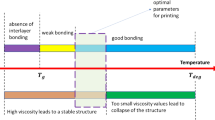Abstract
A stamping process is widely used for fabricating various sheet metal parts for vehicles, airplanes, and electronic devices by the merit of low processing cost and high productivity. Recently, the use of thin sheets with a corrugated structure for sheet metal parts has rapidly increased for use in energy management devices, such as heat exchangers, separators in fuel cells, and many others. However, it is not easy to make thin corrugated structures directly using a single-step stamping process due to their geometrical complexity and very thin thickness. To solve this problem, a multi-step stamping (MSS) process that includes a heat treatment process to improve formability is proposed in this work: the sequential process is the initial stamping, heat treatment, and final shaping. By the proposed method, we achieved successful results in fabricating thin corrugated structures with an average thickness of 75 μm and increased formability of about 31% compared to the single-step stamping process. Such structures can be used in a plate-type heat exchanger requiring low weight and a compact shape.
Similar content being viewed by others
References
A. Y. C. Nee, PC-based computer aids in sheet-metal working, J. Mech. Work. Technol., 19 (1989) 11–21.
S. A. Wang, An experimental study of corrugated steel sheet solar water heater, Solar Energy, 23(4) (1979) 333–341.
S. Kakac and H. Liu, Heat exchangers: Selection, rating and thermal design, 2nd Ed. CRC Press, New York, USA (2002).
T. Kuppan, Heat exchanger design handbook, 1st Ed. CRC Press, New York, USA (2000).
J. M. Coulson and J. F. Richardson, Coulson & Richarson’s chemical engineering volume 1, 6th Ed. Butterworth Heinemann (1999).
S. H. Noie, Investigation of thermal performance of an airto-air thermosyphon heat exchanger using — NTU method, Appl. Therm. Eng., 26 (2006) 559–567.
F. Yang, X. Yuan and G. Lin, Waste heat recovery using heat pipe heat exchanger for heating automobile using exhaust gas, Appl. Therm. Eng., 23 (2003) 367–372.
J. A. W. Gut et al., Thermal model validation of plate heat exchangers with generalized configurations, Chem. Eng. Sci., 59 (2004) 4591–4600.
P. Vlasogiannis et al., Air-water two-phase flow and heat transfer in a plate heat exchanger, Int. J. Multiphase Flow, 28(5) (2002) 757–772.
R. V. Rao and V. Patel, Design optimization of shell and tube heat exchangers using swam optimization algorithms, Proc. Inst. Mech. Eng. A: J. Power. Energy, 225 (2011) 619–634.
A. K. Dwivedi and K. S. Das, Dynamics of plate heat exchangers subject to flow variations, Int. J. Heat and Mass Transf., 50(13-14) (2007) 2733–2740.
H. S. Jang and D. S. Park, Microfabrication of microchannels for fuel cell plates, Sensors, 10 (2010) 167–175.
S. Augustin, V. Hennige, G. Horpel and C. Hying, Ceramic but flexible: New ceramic membrane foils for fuel cells and batteries, Desalination, 146 (2002) 23–28.
V. Mehta and J. S. Cooper, Review and analysis of PEM fuel cell design and manufacturing, J. Power Sources, 114 (2003) 32–53.
ASM Handbook Vol.4: Heat treating (1991) (ASM International).
B. Craig, Hydrogen damage, ASM Handbook, Vol. 13A Corrosion: Fundamentals, Testing, and Protection, ASM International (2003) 374.
H. B. Shim, Improving formability to develop miniature stamping technologies, Int. J. Prec. Eng. and Manuf., 10(2) (2009) 117–125.
L. Zhou, K.-M. Xue and P. Li, Determination and application of stress-based forming limit diagram in aluminum tube hydroforming, Trans. Nonferrous Met. Soc. China, 17 (2007) s21–s26.
M. A. Kulas, P. E. Krajewski, J. R. Bradley and E. M. Taleff, Forming limit diagrams for AA5083 under SPF and QPF conditions, Mate. Sci. Forum, 551-552 (2007) 129–134.
S. Hiwatashi, A. Bael, P. Houtte and C. Teodosiu, Prediction of forming limit strains under strain-path changes: application of an anisotropic model based on texture and dislocation structure, Int. J. Plasticity, 14(7) (1998) 647–669.
M. Gerdooei and B. M. Dariani, Strain-rate-dependent forming limit diagrams for sheet metals, Proc. Inst. Mech. Eng. B: J. Eng. Manuf., 12 (2008) 1651–1659.
M. Loh-Mousavi, M. Bakhshi-Jooybari, K.-I. Mori and K. Hyashi, Improvement of formability in T-shape hydroforming of tubes by pulsating pressure, Proc. Inst. Mech. Eng. B: J. Eng. Manuf., 222(9) (2008) 1139–1146.
Author information
Authors and Affiliations
Corresponding author
Additional information
Recommended by Associate Editor Youngseog Lee
Sung-Woo Choi is an engineer with Advanced Development Team in Refrigerator R&D Lab, LG Electronics. He has a bachelor’s degree from Dong-A University and a master’s from Pusan National University in 2011. Present research field is the new structural design of a refrigerator.
Sang-Hu Park is a professor in the School of Mechanical Engineering, Pusan National University. His research fields are nano/microfabrication, sheet metal forming, and optimal structure design. He is a member of KSME, KSPE, and KPEA. Also, he is a professor in PNU-Rolls Royce University Technology Centre, and is in charge of manufacturing technology.
Rights and permissions
About this article
Cite this article
Choi, SW., Park, S.H., Jeong, HS. et al. Improvement of formability for fabricating thin continuously corrugated structures in sheet metal forming process. J Mech Sci Technol 26, 2397–2403 (2012). https://doi.org/10.1007/s12206-012-0616-z
Received:
Revised:
Accepted:
Published:
Issue Date:
DOI: https://doi.org/10.1007/s12206-012-0616-z




